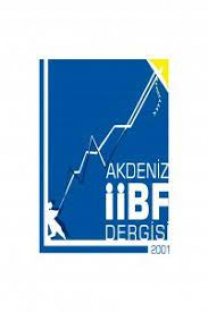DETERMINATION OF THE EFFICIENCY OF THE TURKISH BANKS AND OUTPUTS' CONTRIBUTIONS TO THE EFFICIENCY AND TFP: DEA WITH PANEL REGRESSION
TÜRK BANKACILIĞINDA ETKİNLİĞİN BELİRLENMESİ VE ÇIKTILARIN ETKİNLİK VE TFV ÜZERİNE ETKİSİ: PANEL REGRESYONLU VZA ANALİZİ
___
- AVKIRAN, N.K., (2011). Association of DEA super-efficiency estimates with financial ratios: Investigating the case for Chinese banks, Omega, 39, 323334. BALGATI, B.H. (2008). Econometrics. Berlin: Springer. BANKER, R.D., CHARNES, A., and COOPER, W. W., (1984). Some models for estimating technical and scale inefficiencies in data envelopment analysis, Management Science, 30(9), 1078-1092. CAVES, D., CHRISTIENSEN, L.R. and DIEWERT, W.E., (1982). The economic theory of indeks numbers and the measurement of input, output and productivity. Econometrica, 50, 1393-1414. CHARNES, A., COOPER, W.W., and RHODES, E. (1978). Measuring the efficiency of decision making units. European Journal of Operational Research, 2, 429-444. CHARNES, A., COOPER, W. W. and RHODES, E. (1979). Short communication: Measuring the efficiency of decision making units. European Journal of Operational Research, 3, 339. COOPER, W. W., SEIFORD, L.M. and TONE, K. (2006). Introduction to data envelopment analysis and its uses. New York: Springer. COŞKUN, M., ARDOR, H. N., ÇERMIKLI, A. H., ERUYGUR, H. O., ÖZTÜRK, F., TOKATLIOĞLU, İ., AYKAÇ, G., and DAĞLAROĞLU, T., (2012). Türkiyede bankacılık sektörü piyasa yapısı, firma davranışları ve rekabet analizi. İstanbul: Türkiye Bankalar Birliği. DAS, A., AND GHOSH, S., (2006). Financial deregulation and efficiency: An empirical analysis of Indian banks during the post reform period, Review of Financial Economics, 15, 193221. DEBREU, G. (1951). The coefficient of resource utilization. Econometrica, 19(3), 273292. DENIZER, C. A., DINC, M., AND TARIMCILAR, M., (2007). Financial liberalization and banking efficiency: evidence from Turkey, Journal of Productivity Analysis, 27, 177195. doi: 10.1007/s11123-007- 0035-9. FARRELL, M. J. (1957). The measurement of productive efficiency. Journal of the Royal Statistical Society, 120(3), 253281. FUKUYAMA, H., and MATOUSEK, R, (2011). Efficiency of Turkish banking: Two-stage network system. Variable returns to scale model, Journal of International Financial Markets, Institutions & Money, 21, 7591. doi:10.1016/j.intfin.2010.08.004. GUJARATI, D.N. (2004). Basic Econometrics, 4th Ed.. New York: McGraw Hill. HAVRANEK, T. and IRSOVA, Z., (2013). Determinants of bank performance in transition countries: A data envelopment analysis, Transition Studies Review, 20, 1-17. doi: 10.1007/s11300-013-0270- x ISIK, I. AND HASSAN, M. K., (2003). Financial deregulation and total factor productivity change: An empirical study of Turkish commercial banks, Journal of Banking & Finance, 27, 14551485. doi:10.1016/S0378-4266(02)00288-1. KABASAKAL, A., KUTLAR, A., and SARIKAYA, M., (2013). Efficiency determinations of the worldwide railway companies via DEA and contributions of the outputs to the efficiency and TFP by panel regression, Central European Journal of Operations Research. doi:10.1007/s10100-013-0303-x. KOOPMANS, T.C. (1951). An analysis of production as an efficient combination of activities. Koopmans, T. C. (ed), Activity Analysis of production and allocation. New Jersey: John Wiley and Sons. KUMBHAKAR, S.C. AND LOVELL, C.A.K. (2000). Stochastic frontier analysis. U.K.: Cambridge University Pres. LIU, F.F. and WANG, P.H. (2008). DEA Malmquist productivity measure: Taiwanese semiconductor companies. International Journal of Production Economics, 112, 367-379. MALMQUIST S., (1953). Indeks number and indifferences surfaces. Trabajos de Estatistica, 4, 209-242. MERCAN, M., REISMAN, A., YOLALAN, R., and EMEL. A. B.( 2003). The effect of scale and mode of ownership on the financial performance of the Turkish banking sector: results of a DEA-based analysis, Socio-Economic Planning Sciences 37, 185202. doi:10.1016/S0038-0121(02)00045-9 PASIOURAS, F., (2008). Estimating the technical and scale efficiency of Greek commercial banks: The impact of credit risk, off-balance sheet activities, and international operations, Research in International Business and Finance, 22, 301-318. STAUB, R.B., SOUZA, G.S., and TABAK, B.M., (2010). Innovative applications of O.R. evolution of bank efficiency in Brazil: A DEA approach, European Journal of Operational Research, 202, 204 213. UNVAN, Y. A. and TATLIDIL, H. (2012). Efficiency in the Turkish banking system: A data envelopment approach, International Journal of Basic & Applied Sciences, 12(02) 168-186.
- ISSN: 1302-9975
- Yayın Aralığı: Yılda 2 Sayı
- Başlangıç: 2001
- Yayıncı: Akdeniz Üniversitesi
Ali KABASAKAL, Aziz KUTLAR, Murat SARIKAYA
ANTALYA'DA KONUT FİYATLARINI ETKİLEYEN FAKTÖRLERİN HEDONİK FİYAT MODELİ İLE TAHMİN EDİLMESİ
Mehmet MERT, Sayım IŞIK, Gizem KÖRDİŞ
ALANYA'DAKİ YERLEŞİK YABANCILARIN MİLLİYETLERİNE GÖRE SATIN ALMA DAVRANIŞLARININ İNCELENMESİ
Mustafa KAVACIK, Ufuk DURNA, Mehmet Emin İNAL, Saadet ZAFER KAVACIK
